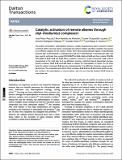Por favor, use este identificador para citar o enlazar a este item:
http://hdl.handle.net/10261/342719COMPARTIR / EXPORTAR:
 SHARE
BASE SHARE
BASE
|
|
| Visualizar otros formatos: MARC | Dublin Core | RDF | ORE | MODS | METS | DIDL | DATACITE | |

| Título: | Catalytic activation of remote alkenes through silyl-rhodium(iii) complexes |
Autor: | Prieto-Pascual, Unai; Martínez de Morentin, Aitor; Choquesillo-Lazarte, Duane CSIC ORCID; Rodríguez-Diéguez, Antonio; Freixa, Zoraida; Huertos, Miguel A. | Palabras clave: | Catalyst activity Hydrosilylation Ligands Rhodium compounds Synthesis (chemical) X ray diffraction Bidentate ligands Catalytic activation Cationics Hydrosilylation reaction Hydrosilylations Isomerisation Rhodium complexes Silicon-based X- ray diffractions Olefins |
Fecha de publicación: | 30-may-2023 | Editor: | Royal Society of Chemistry (UK) | Citación: | Dalton Transactions 52: 9090-9096 (2023) | Resumen: | The tandem isomerization-hydrosilylation reaction is a highly valuable process able to transform mixtures of internal olefins into linear silanes. Unsaturated and cationic hydrido-silyl-Rh(iii) complexes have proven to be effective catalysts for this reaction. Herein, three silicon-based bidentate ligands, 8-(dimethylsilyl)quinoline (L1), 8-(dimethylsilyl)-2-methylquinoline (L2) and 4-(dimethylsilyl)-9-phenylacridine (L3), have been used to synthesize three neutral [RhCl(H)(L)PPh] (1-L1, 1-L2 and 1-L3) and three cationic [Rh(H)(L)(PPh)][BAr] (2-L1, 2-L2 and 2-L3) Rh(iii) complexes. Among the neutral compounds, 1-L2 could be characterized in the solid state by X-ray diffraction showing a distorted trigonal bipyramidal structure. Neutral complexes (1-L1, 1-L2 and 1-L3) failed to catalyze the hydrosilylation of olefins. On the other hand, the cationic compound 2-L2 was also characterized by X-ray diffraction showing a square pyramidal structure. The unsaturated and cationic Rh(iii) complexes 2-L1, 2-L2 and 2-L3 showed significant catalytic activity in the hydrosilylation of remote alkenes, with the most sterically hindered (2-L2) being the most active one. | Versión del editor: | http://dx.doi.org/10.1039/d3dt00624g | URI: | http://hdl.handle.net/10261/342719 | Identificadores: | doi: 10.1039/d3dt00624g issn: 1477-9234 |
| Aparece en las colecciones: | (IACT) Artículos |
Ficheros en este ítem:
| Fichero | Descripción | Tamaño | Formato | |
|---|---|---|---|---|
| 2023_DaltonTransact52_9090.pdf | 990,29 kB | Adobe PDF |  Visualizar/Abrir |
CORE Recommender
Este item está licenciado bajo una Licencia Creative Commons

